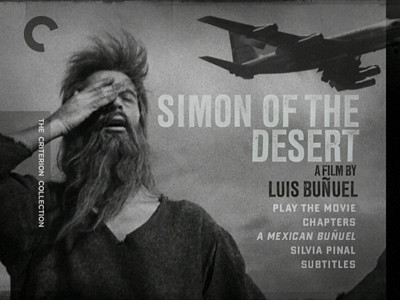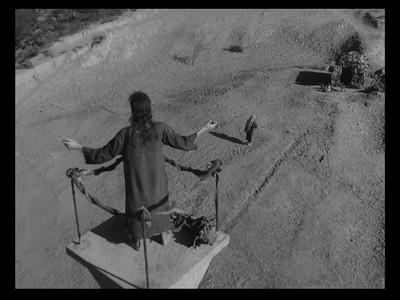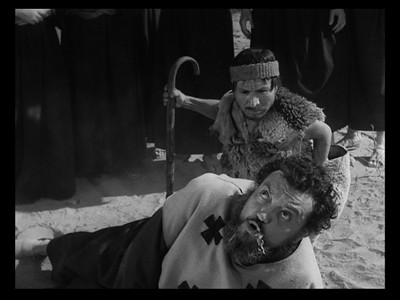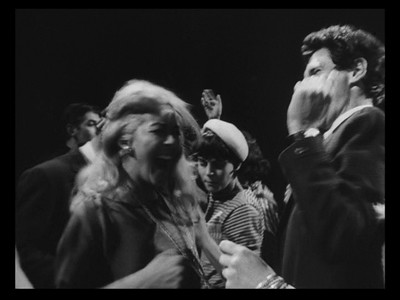
Luis Bunuel's 1965 short film Simon of the Desert may be one of the master surrealist's more straightforward efforts--or, at least, it should be straightforward enough to anyone raised with regular doses of Sunday School. The church I grew up in didn't believe in saints, but the temptations that Bunuel's Simon, whom he based on the story of Saint Simeon Stylites, will look familiar to anyone who has heard the
tale of Jesus being tempted by Satan in the desert.

Simon (Claudio Brook) is a Christian ascetic who has been living atop a literal pedestal of religion for six years, six months, and six days. This life of denial and penitence, undertaken in the middle of a scorched desert, will prove his devotion to God and bring him closer to Heaven. Believers flock around him, other holy men revere him, and Simon shares the lessons he's learned with them all. As the film opens, a grateful patron is moving Simon from his simple pedestal to a fancier, taller tower that has been erected in his honor--an earthly reward for his persistent pursuit of divinity.
Perhaps it is the acceptance of this gift, or perhaps it's the auspicious and evil number inlaid in the duration of Simon's meditation, but the devil has now come to the desert to try to lure Simon down from his place of worship. The trickster appears as a woman (Silvia Pinal), first as a naughty schoolgirl and then in the guise of Jesus Himself. Satan also takes possession of a jealous priest to try to shake the people's belief in Simon through lies. These efforts fail, only giving the target more strength: Simon makes his vigil tougher, swearing to stand on only one leg.

For a notorious prankster who often had a laugh at the expense of organized faith, Bunuel portrays Simon's spiritual mission with the utmost respect. He still can't resist having a go at the false worshippers and dishonest holy men, however, showing how the gathered take advantage of Simon's miracles and how many priests are only coming to give tribute for the sake of appearances. In Bunuel's philosophy, the phony far outnumber the authentic.
And we do see that Simon is authentic because we see his temptations and his renunciation of the same. This doesn't just include the ones brought forth by Satan--though those are brought to life with showmanship and rather good special effects--but also the ones that creep into Simon's mind via normal trains of thought. Like Scorsese's portrait of Jesus in The Last Temptation of Christ, Simon sees himself in more normal surroundings, accepting love and family as his own, but he banishes such thoughts from his mind in affirmation of his faith.

There is only one thing that Simon cannot stand up against, and it is Satan's final gambit. Arguably, the sin of pride could also be Simon's downfall, with how zealously he challenges the devil to unload the full arsenal, but this is what the fallen one is relying on. In a Twilight Zone-worthy twist, the Devil transports Simon to a future city. Looking now like an existentially weary beatnik, Simon sits with the beautiful arc angel at a table in a rock 'n' roll club. When Simon finds nothing of interest in the bawdy decadence and demands to be returned home to his pedestal, Satan tells him that it is too late, that he has already been replaced--the implication being that he has not been replaced by another ascetic, but by modern life, by a society that rejects the oppressiveness of religion for the freedom of music and technology. Satan joins in the dance, laughing, leaving Simon alone in his 20th-century despair.
Ah, there's the rub! Here is where Bunuel lies in wait to needle the religious rank and file. In the closing sequence of Simon of the Desert, which spends a long time amongst the kids dancing before moving over to the bored looking Simon, thus letting us know how fun it is on the dancefloor, Bunuel is getting the last laugh, fulfilled for him in the bright and lovely smile of Silvia Pinal. “You may have been right,” he seems to say to Simon, “but what good has it done you? The other side won anyway.”

For a full rundown on the special features, read the full article at DVD Talk.

1 comment:
In Federico Fellini's JULIET OF THE SPIRITS, the titular character has visions of her Sunday school teacher as Simon.
That is, a Simon that looks suspiciously and uncannily similar to Bunuel's. Only Fellini's Simon has a flaming red beard and is only seen once on a giant pillar
in the middle of nowhere.
Post a Comment